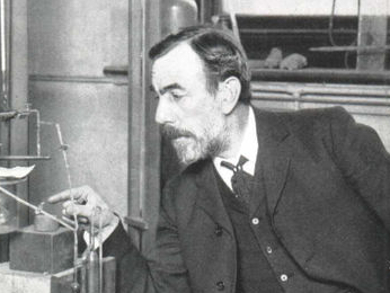William Ramsay was born in Glasgow, UK, on October 2, 1852. Starting in early childhood, he studied both languages and science. After breaking a leg playing football, the teen-aged Ramsay fought the boredom during convalescence by experimenting with chemicals and trying to build fireworks.
Ramsay was brought up in a Calvinistic family and originally supposed to join the clergy. However, one year after he entered Glasgow University to study classics, he decided to become a chemist instead. He received his Ph.D. in organic chemistry from the University of Tübingen, Germany, in 1873.
William Ramsay then returned to Glasgow University and became assistant to the Professor of Chemistry there. In 1879, he was appointed Professor of Chemistry at University College, Bristol, UK, and in 1887, Ramsay moved to London to work as Chair of Chemistry at University College (UCL). In the time since his Ph.D., his focus had switched from organic chemistry to physical chemistry, particularly of gases.
In London, Ramsay made his most important scientific discoveries. In 1894, he attended a lecture by Lord Rayleigh at the Royal Society. Rayleigh had discovered that nitrogen from air seemed to have a higher density than nitrogen obtained by chemical synthesis and was looking for a reason for the discrepancy. This reason was jointly discovered by Ramsey and Rayleigh that same year: Air contains small quantities of argon, which has a higher density than nitrogen. The name “argon” comes from the Greek word for lazy or inactive, and was chosen because the gas seemed to be chemically inert.
The following year, 1895, Ramsay was the first scientist to isolate and characterize helium, which had previously been found in the sun’s spectrum. He obtained the inert gas by heating the uranium mineral cleveite, which contains helium as a product of radioactive α-decay. The position of the two noble gases in the periodic table indicated an entirely new group of missing elements, and Ramsay set out to find the rest. Together with Morris W. Travers, he discovered neon, krypton, and xenon, all in 1898, by fractional distillation of large amounts of liquified air.
For his discoveries, Ramsay was knighted in 1902 and received the Nobel Prize in Chemistry in 1904. Sir William Ramsay spent his final years in Buckinghamshire, where he died on July 23, 1916.
Sir William Ramsay is the answer to Guess the Chemist (55).
Sources
- Argon and the Non-Inert Pair: Rayleigh and Ramsay,
John Meurig Thomas,
Angew. Chem. Int. Ed. 2004, 43, 6418–6424.
DOI: 10.1002/anie.200461824 - Sir William Ramsay – Biographical,
in Nobel Lectures, Chemistry 1901-1921, Elsevier Publishing Company, Amsterdam, 1966. - Sir William Ramsay, K. C. B.,
Theodore W. Richards,
Proc. Am. Philos. Soc. 1917, 56, iii-viii.
Selected Publications
- An Attempt to Estimate the Relative Amounts of Krypton and of Xenon in Atmospheric Air,
W. Ramsay,
Proc. R. Soc. London 1902, 71, 421–426.
DOI: 10.1098/rspl.1902.0121 - On a New Constituent of Atmospheric Air,
W. Ramsay, M. W. Travers,
Proc. R. Soc. London 1898, 63, 405–408.
DOI: 10.1098/rspl.1898.0051 - On the Companions of Argon,
W. Ramsay, M. W. Travers,
Proc. R. Soc. London 1898, 63, 437–440.
DOI: 10.1098/rspl.1898.0057 - Helium, a Gaseous Constituent of Certain Minerals. Part II – Density,
W. Ramsay,
Proc. R. Soc. London 1895, 59, 325–330.
DOI: 10.1098/rspl.1895.0097 - Helium, a Gaseous Constituent of Certain Minerals. Part I,
W. Ramsay,
Proc. R. Soc. London 1895, 58, 80–89.
DOI: 10.1098/rspl.1895.0010 - On a Gas Showing the Spectrum of Helium, the Reputed Cause of D3, One of the Lines in the Coronal Spectrum. Preliminary Note,
W. Ramsay,
Proc. R. Soc. London 1895, 58, 65–67.
DOI: 10.1098/rspl.1895.0006 - Argon, a New Constituent of the Atmosphere,
L. Rayleigh, W. Ramsay,
Proc. R. Soc. London 1894, 57, 265–287.
DOI: 10.1098/rspl.1894.0149 - A system of inorganic chemistry,
W. Ramsay,
J. & A. Churchill, London, 1891.



